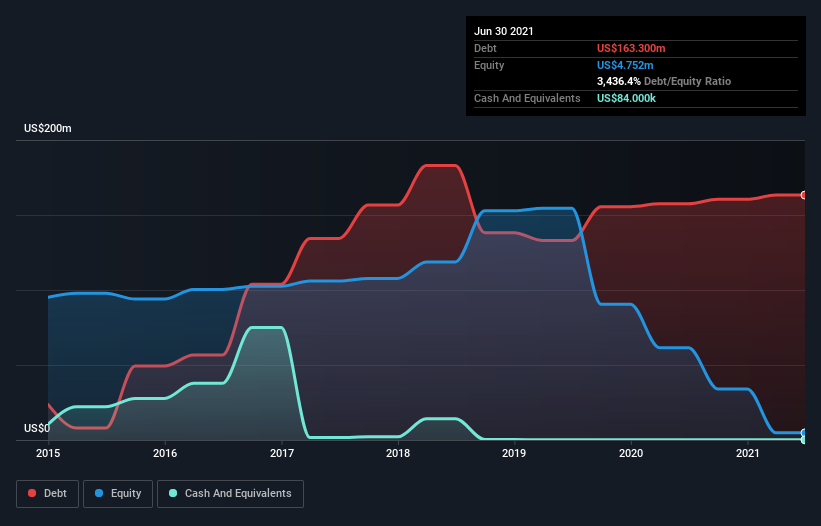- Hong Kong
- /
- Trade Distributors
- /
- SEHK:2112
CAA Resources (HKG:2112) Has Debt But No Earnings; Should You Worry?

Warren Buffett famously said, 'Volatility is far from synonymous with risk.' So it seems the smart money knows that debt - which is usually involved in bankruptcies - is a very important factor, when you assess how risky a company is. Importantly, CAA Resources Limited (HKG:2112) does carry debt. But the real question is whether this debt is making the company risky.
Why Does Debt Bring Risk?
Generally speaking, debt only becomes a real problem when a company can't easily pay it off, either by raising capital or with its own cash flow. If things get really bad, the lenders can take control of the business. However, a more usual (but still expensive) situation is where a company must dilute shareholders at a cheap share price simply to get debt under control. By replacing dilution, though, debt can be an extremely good tool for businesses that need capital to invest in growth at high rates of return. The first thing to do when considering how much debt a business uses is to look at its cash and debt together.
Check out our latest analysis for CAA Resources
What Is CAA Resources's Net Debt?
The chart below, which you can click on for greater detail, shows that CAA Resources had US$163.3m in debt in June 2021; about the same as the year before. Net debt is about the same, since the it doesn't have much cash.

How Strong Is CAA Resources' Balance Sheet?
The latest balance sheet data shows that CAA Resources had liabilities of US$200.0m due within a year, and liabilities of US$3.46m falling due after that. Offsetting this, it had US$84.0k in cash and US$186.0m in receivables that were due within 12 months. So it has liabilities totalling US$17.3m more than its cash and near-term receivables, combined.
Given this deficit is actually higher than the company's market capitalization of US$14.4m, we think shareholders really should watch CAA Resources's debt levels, like a parent watching their child ride a bike for the first time. Hypothetically, extremely heavy dilution would be required if the company were forced to pay down its liabilities by raising capital at the current share price. When analysing debt levels, the balance sheet is the obvious place to start. But you can't view debt in total isolation; since CAA Resources will need earnings to service that debt. So when considering debt, it's definitely worth looking at the earnings trend. Click here for an interactive snapshot.
Over 12 months, CAA Resources made a loss at the EBIT level, and saw its revenue drop to US$28m, which is a fall of 88%. That makes us nervous, to say the least.
Caveat Emptor
While CAA Resources's falling revenue is about as heartwarming as a wet blanket, arguably its earnings before interest and tax (EBIT) loss is even less appealing. Indeed, it lost a very considerable US$4.7m at the EBIT level. When we look at that alongside the significant liabilities, we're not particularly confident about the company. It would need to improve its operations quickly for us to be interested in it. Not least because it burned through US$574k in negative free cash flow over the last year. So suffice it to say we consider the stock to be risky. When analysing debt levels, the balance sheet is the obvious place to start. But ultimately, every company can contain risks that exist outside of the balance sheet. For instance, we've identified 3 warning signs for CAA Resources (2 can't be ignored) you should be aware of.
When all is said and done, sometimes its easier to focus on companies that don't even need debt. Readers can access a list of growth stocks with zero net debt 100% free, right now.
New: Manage All Your Stock Portfolios in One Place
We've created the ultimate portfolio companion for stock investors, and it's free.
• Connect an unlimited number of Portfolios and see your total in one currency
• Be alerted to new Warning Signs or Risks via email or mobile
• Track the Fair Value of your stocks
Have feedback on this article? Concerned about the content? Get in touch with us directly. Alternatively, email editorial-team (at) simplywallst.com.
This article by Simply Wall St is general in nature. We provide commentary based on historical data and analyst forecasts only using an unbiased methodology and our articles are not intended to be financial advice. It does not constitute a recommendation to buy or sell any stock, and does not take account of your objectives, or your financial situation. We aim to bring you long-term focused analysis driven by fundamental data. Note that our analysis may not factor in the latest price-sensitive company announcements or qualitative material. Simply Wall St has no position in any stocks mentioned.
About SEHK:2112
Grace Life-tech Holdings
An investment holding company, engages in the research, development, and application of plant stem cell technology.
Low with imperfect balance sheet.
Market Insights
Community Narratives



